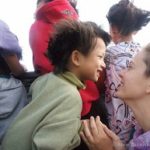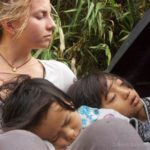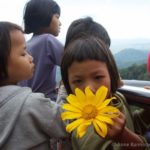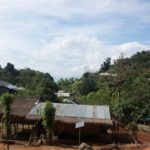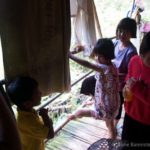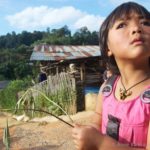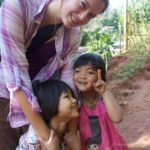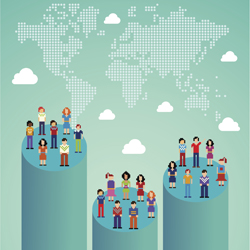 Michael Shafer
Michael Shafer
Founder, Warm Heart
Ken Gilmore
Associate Professor of Political Science, Guilford College
Cecilia Orphan
Doctoral Student in Higher Education, University of Pennsylvania
Anne Bannister
Student, Southwestern University
Abstract
At 55, nearing the end of an academic sabbatical, Michael Shafer decided that the microenterprise work he had started in Thailand had become more like a life’s calling. He resigned from Rutgers University and started the Warm Heart project with his wife Evelind Schecter. The Warm Heart organization was established by Michael and Evelind in rural Thailand. In this informative interview, Michael shares his experience and understanding about the impact of social entrepreneurship. Interview responses by: Ken Gilmore, “What motivates a scholar to become a social entrepreneur?”; Cecilia Orphan, “Is social entrepreneurship an effective way to alleviate poverty?”; and Anne Bannister, A photo essay providing insight into an undergraduate intern’s experience working in the Warm Heart project.
Read the responses to the interview:
- Response #1: Ken Gilmore, “What motivates a scholar to become a social entrepreneur?”
- Response #2: Cecilia Orphan, “Is social entrepreneurship an effective way to alleviate poverty?”
- Response #3: Anne Bannister, A photo essay providing insight into an undergraduate intern’s experience working in the Warm Heart project
Response #1 to Warm Heart video by D. Michael Schafer
Ken Gilmore is an associate professor in the Department of Political Science, Guilford College.
I first met Professor D. Michael Shafer as a wide-eyed, first-year graduate student at Rutgers University, twenty-five long years ago. A brilliant political economist and charismatic teacher, Michael was always the smartest guy in the seminar room. Warm and generous with his time, he became my mentor, dissertation advisor, and friend. As is common to the graduate experience, however, we lost touch after I left Rutgers for a teaching job in Texas. We have not found the opportunity to speak in nearly twenty years.
Now, many years later, I find my mentor is living in a remote compound by the Mae Ngat River in the jungles of northern Thailand. He has walked away from a comfortable, tenured life, and gone “up river” to put his theories to practical use—helping to create sustainable incomes for the poorest of the poor. Good for him and good for humanity. But, watching the interview, I cannot help but wonder: what motivates such a gifted scholar and teacher to take that journey—to, literally and figuratively, “get off the boat”?
Perhaps Michael grew tired of the seeming meaninglessness of much of what we, as academics, do. Certainly, as the years pass, many of us become disillusioned with academia, with its emphasis on what Robert Putnam called, the vocational interests of publications, teaching, scholarly awards, and job security (2003). Unfortunately, Michael’s critique of poverty reduction programs is too easily applied to our own profession. We often provide solutions to problems we don’t truly understand, or offer solutions to problems that don’t exist. If our students pass the test, we claim success. If they don’t, it’s their fault, not ours. We rarely stop to consider our own “perfect failure rate.”
More to the point, if, as Michael suggests, the value of social entrepreneurship is in the empowerment of the recipients of assistance, how do we “create value” in what we do as academics? Here, Shafer has it right: “You start way deep down at the grassroots” by letting go of the idea that what happens in our classroom is somehow vastly important (let’s face it, students gain more from sitting with “real people” than from sitting at our feet); by teaching our students to extract generalizations from their experiences; and by having them confront the creative problem of bringing resources and people together. The entrepreneur, in whatever profession, is willing to risk it all—to look like an absolute idiot, admit he’s wrong and start all over.
Michael gets something else right: most of us are not willing to bet everything—on anything. How many of us would sell the home, quit the cushy job, and set up camp in the jungle, no matter how worthy the cause? True, for many of us, graduate school was risky enough—no family support, no funding, plenty of debt, and slim job prospects. In the words of Antarctic explorer Ernest Shackleton’s Antarctic recruitment ad, “small wages, long months of complete darkness… safe return doubtful.” If we’re lucky enough to get a tenure track job, it’s understandable if we clutch the rock of security that is tenured-lifetime employment. We settle in. Teach our courses. Publish. Stay on the boat.
That was never Shafer’s nature. In the time I knew him, Michael never treated the tenured life as an end in itself, but rather as a means to something more tangible and permanent. To say that he “walked away” from academia assumes that he ever planned to stay in the first place. On the contrary, Warm Heart, and all that he has built in the jungles of Thailand, feels more like the culmination of a lifetime of study—part of the trajectory and momentum of his life. We should all find such clarity of purpose.
In the end, Shafer’s example is both discomforting and inspiring. It challenges us to think about the trajectory and momentum of our own lives, about how (or if) to “get off the boat.” Graduate school taught us always to approach our scholarship with a critical eye; how often do we apply that critical eye to our own lives and purposes? Even if we are largely satisfied with our journey “up river,” thus far, what new risks—new venues and directions—might we take in our professional lives, to measure ourselves in new and more challenging ways? I am grateful to the organizers of this volume for the opportunity to offer my reflections upon seeing my old mentor and friend. Michael inspired me twenty-five years ago—probably, more than he knows—and I continue to be inspired by his example to this day.
Response #2 to Warm Heart video by D. Michael Shafer
Cecilia M. Orphan is a doctoral candidate in Higher Education at the Graduate School of Education, University of Pennsylvania.
The appeal of social entrepreneurship is undeniable. The idea that one can help others while making money appeals to the faith many in the Western world have in capitalism (Berlant, 2011). Social entrepreneurship refers to the application of business strategies to address social problems. As described by Michael Shafer, social entrepreneurship assumes an asset-based approach to understanding poverty, and posits that poor people are smart and capable problem solvers. Social entrepreneurs believe in the efficacy of the ‘invisible hand’ of capitalism to alleviate poverty, and as such take pride in being motivated by profits (Karnani, 2007; Yunus, 2009). With the exception of wholly owned community businesses in which profits are shared directly with the community (‘social businesses’ as termed by Muhammed Yunus in 2004), these organizations derive profits for investors and venture capitalists. The rationale for pursuing profit is that doing so creates efficiency in addressing social problems. If a strategy is not successful, funders will no longer invest and, as Michael Shafer states, clients will stop buying products.
Social entrepreneurial organizations partner with people in communities to manufacture products for sale in global markets. The rationale for these partnerships is that people in communities around the world are talented artisans lacking only capital and a global market for their goods. Another prevalent form of social entrepreneurship is microlending, the lending of small amounts of money to people at fairly high interest rates (Karnani, 2007; Toyama, 2011; Yunus, 2009). These loans are often accompanied by expectations that must be fulfilled, one of which is that the money will be used to create a business and not pay for basic needs. Nobel Prize winner Mohammad Yunus is arguably the best known micro-lender in the world. It is Yunus’s belief that poverty exists due to the closure of the international economic system to people in the developing world. Micro-lending thus involves people who historically have been excluded.
Social entrepreneurs reject the assumption that charities are best equipped to address poverty (Yunus, 2009). When leaders of anti-poverty charities speak about the people they serve, they often use deficit-laden language, describing what people lack instead of the assets they possess. As Michael Shafer states in his video, charity provides necessities and services to people who do not have them, creating the “diminution of the recipient to a position of inferiority.” As Shafer astutely points out, another problem with charities is that many operate on three-year programmatic cycles. This is a response to the funding cycles for nonprofits, and whipsaws communities between different strategic priorities. More troubling is what happens when funding runs out, causing the organization’s attention to be directed to another region or issue, leaving the community in a lurch.
While social entrepreneurship seems to make sense when analyzed from a neoliberal framework, and its criticisms of charities are well-founded, it comes with major caveats and as of yet, its impact has not been well measured (Karnani, 2007). With current shifts to investing in social entrepreneurship instead of existing aid organizations, this lack of measurement is deeply troubling. It has been found that social entrepreneurial ventures create debt, employ high interest rates, and can cause strife in communities (Karnani 2007; Toyama, 2011). While I agree with the criticisms of charity work posed by social entrepreneurs (with the caveat that not all operate this way), I am not convinced that social entrepreneurship is the best strategy for addressing global poverty for the following reasons. Social entrepreneurs are rightfully critical of the three-year cycles of charities. It is unclear that businesses and social ventures have more sustained involvement in regions, though. What happens if a social entrepreneur decides that a venture is not profitable? Do they leave the community and if so, what happens in their absence? I agree that people have expertise about the problems facing their communities and likely better understand solutions. I take issue with the assumption that everyone can and should be entrepreneurial, though. In countries with far less poverty, 90% of people in the workforce are employees and not entrepreneurs (Karnani, 2007). Expecting that people in the developing world have the skills necessary to run a successful business is short-sighted and erroneous. These fads also ignore the need for markets of scale and focus instead on cultivating small businesses. Markets of scale are important because large companies require more employees thus increasing workforce participation for more people.
Perhaps most troubling is the tendency of social entrepreneurship to regard people in the developing world as clients and consumers of goods. As Harry Boyte and other critics of neoliberalism have argued, treating people as consumers instead of citizens threatens public life by creating dependencies on service-providers and dulling people’s civic and organizing energy (Boyte, 2012; Giroux, 2002). When citizens are regarded as consumers, they are no longer invited to participate in the problem solving needed to address public problems. Also instructive is Lauren Berlant’s rejection of the dominant conceptualization of capitalism (2011). Berlant theorizes that we are cruelly attached to the notion that capitalism will alleviate inequality. The cruelty of this attachment is derived from the encouragement it provides people for eschewing social and systemic changes in favor of privatization. This criticism is particularly instructive as we consider the rationale for social entrepreneurship. When applying private solutions to public problems, we are assuming that the needs of people can be addressed by the market. This assumption ignores the fact that capitalism often creates poverty. Capitalism is an economic system – not a social system – the main purpose of which is to reduce people to producers, with success being measured by money accumulated and not lives improved.
I have no doubt that social entrepreneurs are passionate about alleviating poverty. We must be cautious when applying market logic to human life, especially notions of efficiency and profit, though. How do you measure efficiency? The efficient delivery of services? The increased earnings of individuals in a community? And what if market forces leads to people taking their lives because they are not able to repay debts to micro-lenders, as happened in India in 2010 (Karnani, 2007)? The appeal of social entrepreneurship is understandable given how incremental progress has been toward the elimination of global poverty. We run into dangerous (and at times deadly) territory when we mix profit motives with the provision of human services, though.
Response #3 to Warm Heart video by D. Michael Shafer
Anne Bannister is an undergraduate student at Southwestern University.
In 2012, as a junior in college I spent six months as an intern for Warm Heart, the organization Michael Shafer and Evelind Schecter established in rural Thailand. It was a rich and moving intercultural learning experience, and it provided a clear sense of what a social entrepreneur can achieve in the world, even far from home. At Warm Heart, I served as Director of Communications, and my photography became a lens both into and out of that world. In that role I had the challenging opportunity to document, observe, and contribute to all of the programs that Warm Heart offers. As Michael Shafer described in his interview, the programs are organized under three primary categories: microenterprise, health, and education. Camera ever-present, I worked closely with local community members and with the boys and girls living at the Warm Heart Children’s Home. Warm Heart houses currently over 40 Hill-tribe children from isolated Akha, Karen, and Lisu villages that either have extremely limited educational opportunities or are at risk from drug trafficking along the Thai-Myanmar border. The parents have sent their children away for schooling in a commitment that is at once deeply painful and loving, because they recognize the opportunities that are otherwise unattainable for their children. On my last full day at Warm Heart I joined a group of the children on a quick visit to their home village, a bittersweet experience for me because I knew I was returning to complete my own formal education on the other side of the planet. The following photo story captures the emotional intensity of the journey.
The second to last day I was at Warm Heart, Michael took me and the girls to visit their homes in Arye. It was an incredibly powerful and emotional trip. With the conclusion of the rainy season I had the chance to visit two other villages, but I desperately wanted to see theirs.
We took a full truck into the mountains. Fellow intern Devon and I sat in the back with all seven of the Akha girls and Suda, 18, who is assistant cook at the Children’s Home. The girls’ faces shone with joy. The air in the back of the truck was thick with happiness and love. Knowing I was leaving this in two days time, my heart was heavy. For three hours we were tossed about in the truck. The road was treacherous, but the view stunning. The higher we climbed the more spectacular it became. Obchoei, 5, has a distinctive shrill laugh that can be heard above any clamor. She led all of us in a victorious, cheerful chant, “ZOO ZOO YAY YAY ZOO ZOO!” We were willing the truck to pull through every rut, to conquer every peak, to deliver us to the home the girls were desperate to see.
Arye is nestled in between the peaks of two mountains. My first glimpse of the small village took my breath away. The moment my feet touched the ground, Café, 6, took my hand. As girls went shouting and scattering in all directions, she pulled me down the road toward her house. Her older sister Atittaya, 9, took Devon’s hand. We met Atittaya and Café’s mother, younger sister and brother. The younger sister, who is three, has a lazy eye that the family has had trouble correcting because other kids pull the patch off. I learned later the little brother and an older brother, who is at school in Chiang Mai, both have hemophilia. The family spends everything they have – which is very little to begin with – on treatment for the boys. Immediately the little sister took me by the hand and heart. Though I was a total stranger she grinned and grinned at me and led me on a walk up and around the curved road the village is built on.
Nipa asked me and Devon to have lunch as guests in her home. She, her mother, and Suda prepared a feast for us on the fire in the kitchen corner of the one-room house. We sampled boiled and fried worms and an amazing dish of pork ground with herbs and lime. Nipa’s father welcomed us to their home and by the end of the meal invited us to be part of the family. I was moved to see Nipa with her parents. They might not have owned many things and her father may drink heavily, but it was clear they love their daughter.
I was very happy to see what appeared to be a highly functioning family. Not all of our kids are so lucky. Obchoei’s father is strung out on a number of drugs and steals any money his wife manages to make. Michael has tried repeatedly to convince the mother to leave and come work for Warm Heart; but she won’t. She says it is her duty as a wife to stay with her husband no matter how bad things get. Karakade’s father was not going to waste an education on a female child. She approached Michael herself asking to come to the Children’s Home. I had heard pieces of each of their stories before, but visiting the village confronted me with their realities on a new level.
I wished that I could have stayed longer. I understood at Warm Heart we were living in a Neverland: a happy, serene environment, shielding children from poverty capable of robbing them of their innocence. At Warm Heart they are not forced to grow up too soon. They live and learn, laugh and play in a space where imagination and creativity are encouraged and youth is protected. Access to a formal Thai education assures that hill tribe children do not remain linguistically, culturally and economically isolated. I hope that these kids use their skills and education to work hard and then give back to their villages. Many of the girls say they want to be teachers. If just one of them decided to teach at the empty one room school in Arye, then already they would be offering an invaluable service and impact the lives of other children.
References
Berlant, L. (2011). Cruel optimism. Durham, NC: Duke University Press.
Karnani, A. (2007). Microfinance misses the mark. Stanford Social Innovation Review, 36(3), p. 34-40.
Toyama, K. (2011, January 28). Lies, hype and profit: The truth about microfinance. The Atlantic Monthly. Retrieved from: http://www.theatlantic.com/business/archive/2011/01/lies-hype-and-profit-the-truth-about-microfinance/70405/.
Yunus, M. (2004). Grameen Bank, microcredit and Millennium Development Goals. Economic and Political Weekly, 39(36), 4-10.
Yunus, M. (2009). Economic security for a world in crisis. World Policy Journal, 26(2), 5-12.
Author Biographies
 Michael Shafer is a serial social entrepreneur, although he heard the term only a decade ago. He started Africa ’73, Inc., his first endeavor, at 17 and hasn’t looked back. Since then he has spent 25 years at Rutgers University teaching international political economy and writing books, 20 years consulting around the world on development and higher education reform, and 15 years training young people to become social entrepreneurs. At 55 he decided it was time to put his money where his mouth was, resigned from Rutgers and started Warm Heart with his wife, Evelind Schecter. For the past 5 years, he has applied body, soul and research design skills to improving the quality of life in a very poor, but very beautiful part of northern Thailand.
Michael Shafer is a serial social entrepreneur, although he heard the term only a decade ago. He started Africa ’73, Inc., his first endeavor, at 17 and hasn’t looked back. Since then he has spent 25 years at Rutgers University teaching international political economy and writing books, 20 years consulting around the world on development and higher education reform, and 15 years training young people to become social entrepreneurs. At 55 he decided it was time to put his money where his mouth was, resigned from Rutgers and started Warm Heart with his wife, Evelind Schecter. For the past 5 years, he has applied body, soul and research design skills to improving the quality of life in a very poor, but very beautiful part of northern Thailand.
 Professor Ken Gilmore teaches International Relations and Political Economy at Guilford College in Greensboro, NC.
Professor Ken Gilmore teaches International Relations and Political Economy at Guilford College in Greensboro, NC.
 Cecilia M. Orphan is a PhD student at the University of Pennsylvania studying the role of universities in democracy. Prior to coming to Penn, Ms. Orphan directed the American Democracy Project, a civic engagement initiative of AASCU. Ms. Orphan serves on the board of The Democracy Imperative and the editorial board of Perspectives on Urban Education. Ms. Orphan is an Imagining America Publicly Active Graduate Education Fellow and a visiting scholar for NERCHE’s Next Generation Engagement Project. Ms. Orphan won the John Saltmarsh Award for Emerging Leaders in Civic Engagement and holds a BA in political science from Portland State University.
Cecilia M. Orphan is a PhD student at the University of Pennsylvania studying the role of universities in democracy. Prior to coming to Penn, Ms. Orphan directed the American Democracy Project, a civic engagement initiative of AASCU. Ms. Orphan serves on the board of The Democracy Imperative and the editorial board of Perspectives on Urban Education. Ms. Orphan is an Imagining America Publicly Active Graduate Education Fellow and a visiting scholar for NERCHE’s Next Generation Engagement Project. Ms. Orphan won the John Saltmarsh Award for Emerging Leaders in Civic Engagement and holds a BA in political science from Portland State University.
 Anne Bannister is a senior at Southwestern University in Georgetown, Texas. In May 2014, she will graduate with a B.A. in Studio Art with a minor in Communications. In the fall of 2013, she interned at Warm Heart, Thailand as Photographer and Director of Communications. Her internship was featured in Southwestern University’s Alumni Magazine and the experience is the basis of her upcoming photography and mixed-media exhibition. In the summer of 2011, Bannister served as official photographer for a delegation from Fort Hays State University on a tour of partner Universities across China. After graduation Bannister plans to pursue a career in photography and hopes that with this art form she can inspire social change.
Anne Bannister is a senior at Southwestern University in Georgetown, Texas. In May 2014, she will graduate with a B.A. in Studio Art with a minor in Communications. In the fall of 2013, she interned at Warm Heart, Thailand as Photographer and Director of Communications. Her internship was featured in Southwestern University’s Alumni Magazine and the experience is the basis of her upcoming photography and mixed-media exhibition. In the summer of 2011, Bannister served as official photographer for a delegation from Fort Hays State University on a tour of partner Universities across China. After graduation Bannister plans to pursue a career in photography and hopes that with this art form she can inspire social change.
